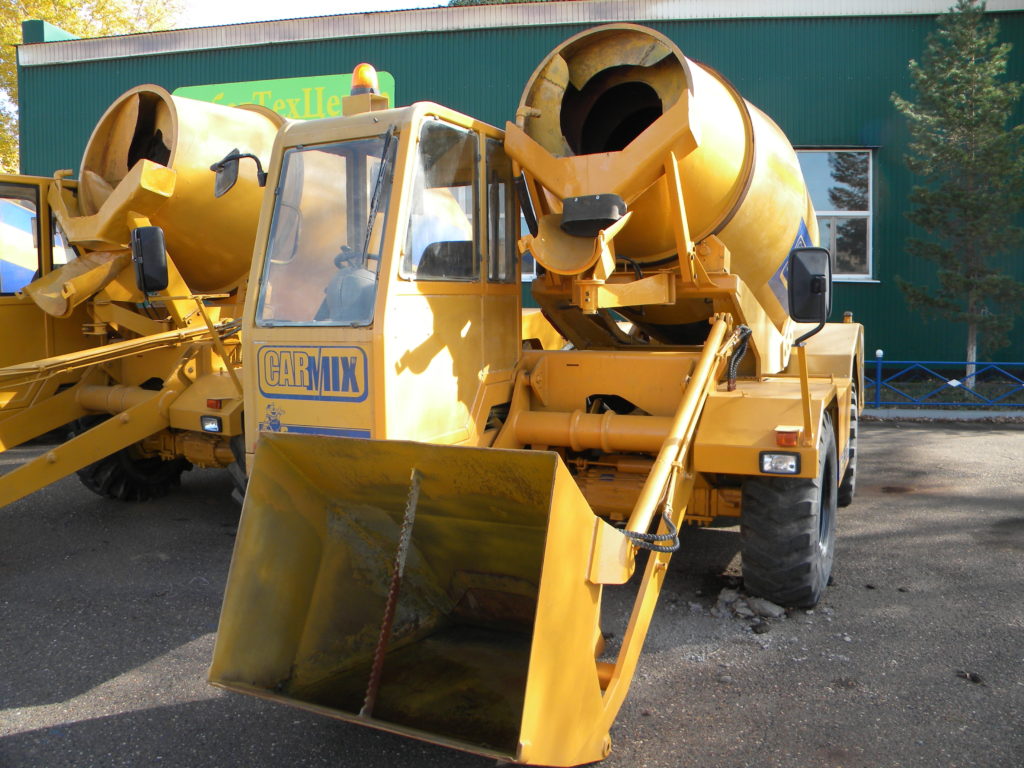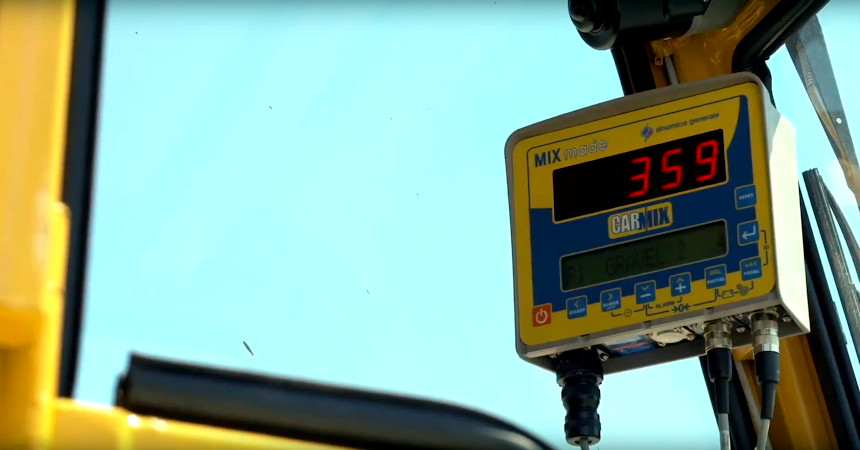Why exactly concrete with carmix is cheaper than any other source?
Content:
- What is a Carmix self loading, mobile concrete mixer?
- What components comprises Carmix?
- How does the concrete production with Carmix look?
- Why is it cheaper to produce concrete with Carmix compared to any other method of concrete production?
The Carmix concrete mixer is a self-loading mobile concrete mixer that allows for on-site concrete production. It is important to note that this is a relatively new concept for the USA, however it has proven its effectiveness in almost all other countries around the globe.
It is important to distinguish between a self loading mixer, that is simply a small drum, usually electrically powered to mix small amounts of concrete on site either from premix bags, or by adding aggregates without any weighting system.

On the contrary, Carmix is a serious and precise equipment, that has its own chassis, diesel engine, loading system etc.
The exact components of the Carmix mixer may vary depending on the specific model and configuration, but generally, a typical Carmix mixer consists of the following:
Chassis: The base structure of the mixer, which includes the engine, transmission, hydraulic system, wheels and other related parts.
Concrete mixer drum: The “container” where the concrete components are mixed. The Carmix mixer uses a drum made of anti-wear steel, which is equipped with screw type steel blades to mix and discharge the concrete.
Loading shovel: A front-loading shovel used to load aggregates, sand, and cement into the mixer drum. The shovel is hydraulically controlled and can be operated from the driver’s seat.
Water system: A water pump and two interconnected tanks with a total capacity of over 210 gallons are used to add water to the mix. The water system is also used to clean the mixer drum and the mixer itself after use. The water system is also equipped with a water meter to be able to control the amount of water used for the mix.
Control panel: A control panel and a joystick in the driver’s cab used to operate the mixer and control the mixing and discharge of concrete.
Weighing system: Perhaps one of the most important systems on a Carmix self loading concrete mixer! A system that weighs the materials added to the mixer, such as cement, aggregates, and water, to ensure the correct proportions are used. The system uses 4 load cells instilled under the drum to control the weight of everything that is loaded and to ensure exact compliance with the mix design. Acceptable loading error for carmix is around 0,5%

The weighting system is also equipped with a printer that will print out a receipt after each batch is completed to reflect the amount of materials loaded, time spent for the batch and the total concrete output, making it easier to control operations on the jobsite.
Overall, the Carmix self loading mobile concrete mixer is a fully mobile concrete batching plant operated by a single operator, capable of producing up to 70 cubic yards of fresh concrete per shift!
The actual concrete production process with Carmix is relatively simple. The new operator training doesn’t usually take longer than 4-5 hours.
The process of producing concrete with Carmix generally follows these steps:
- Desired mix design is loaded into the on board computer of a weighting system.
- Aggregates and cement are loaded into the mixer using the front-loading shovel. The loading shovel is hydraulically controlled and can be operated from the driver’s seat. Every component is weighted and dosed according to the mix design.
- The water needed for the mix is added using the water system, which includes a hydraulically operated high output water pump and a water flow meter.
- All components are mixed in the mixer drum, which is made of anti-wear steel. There is no extra time dedicated for mixing needed. Once the last portion of the aggregate is loaded and Carmix arrives at the pouring site, the concrete is ready to use.
- The concrete is discharged directly from the mixer drum onto the site where it is needed, which can be done quickly and easily using the mixer’s hydraulic controls. Operator can both control the discharge rate to facilitate concrete finishers who place the concrete, and the direction where concrete is discharged, by rotating the drum of the machine or the direction of discharge chutes.
Once concrete is fully discharged, a receipt is automatically printed by the weighting system and the operator can move on to the production of the next batch of concrete or to wash the machine with an onboard high pressure washer system and go home.
In order to understand why Carmix is a cheaper source of concrete than anything else, we first have to look at the cost breakdown of concrete ordered from a batching plant or other external source.
The cost of concrete ordered from an external supplier typically includes several components:
Concrete Mix: The cost of the actual concrete mix itself, which includes the cost of cement, aggregates, water, and any additives or admixtures. The cost of the mix can vary depending on the specific mix design and the type of cement and aggregates used.
Delivery Fees: The cost of transporting the concrete from the supplier’s batching plant to the job site. Delivery fees can vary depending on the distance of the job site from the batching plant, the size of the concrete truck, and any access or site-specific requirements.
Pumping Fees: If a concrete pump is required to place the concrete at the job site, an additional pumping fee may be charged. This fee can vary depending on the type of pump used, the distance and height of the concrete placement, and the duration of the pumping job.
Additional Services: If additional services are required, such as special mix designs, color additives, or special aggregates, additional charges may apply. Additional charges will also apply for delivering not a full mixer of concrete, taking longer than a set amount of time to discharge the concrete at the job site, as well as if you decide to order concrete out of the regular operation hours of the supplier.
Taxes and Fees: Any applicable taxes, fees, or surcharges may be added to the cost of the concrete.
Batching plant overheads: This is everything that is not directly related to the actual concrete. Things like:
- Rent or Mortgage: The cost of renting or owning the land and building where the plant is located.
- Utilities: The cost of electricity, water, gas, and other utilities required to operate the plant.
- Property Taxes: The cost of property taxes on the land and building where the plant is located.
- Insurance: The cost of liability, property, and workers’ compensation insurance to protect the plant and employees.
- Maintenance and Repairs: The cost of maintaining and repairing the plant, including routine maintenance, repairs, and upgrades.
- Office and Administrative Expenses: The cost of office supplies, equipment, and personnel required to manage and operate the plant.
- Marketing and Advertising: The cost of promoting the plant and attracting new customers.
- Legal and Accounting Expenses: The cost of legal and accounting services required to operate the plant and comply with regulations.
Batching plant profit margin:
This is the actual amount of profit that an owner of a batching plant plans to receive after all expenses have been paid. This can be expressed as a certain mark-up percentage per every cubic yard of concrete sold and delivered. The average profit of a batching plant in the USA is anywhere from 10 to 25 percent of the total price.
Now that we know what comprises the total cost of concrete ordered from an external supplier, we can see where Carmix will save us money.
- Cost of the aggregates will be similar to the one of the batching plant
- Carmix only needs one operator to run it, as opposed to multiple employees running a batching plant.
- Carmix only consumes around 2 gallons of diesel per hour!
- Camix doesn`t need any support equipment, such as a loader to load the aggregates or the mixer truck to transport the concrete. Carmix does everything by itself!
- In most cases there is no need for a concrete pump as Carmix can drive us exactly to the area of concrete placement and discharge concrete where needed!
- No delivery expenses as concrete is prepared on site.
- No other overheads!
- No hidden profit margins, you get the concrete at bear cost!
Apart from the above mentioned benefits of using carmix, there are some benefits that have no direct influence on the final cost of the project but will result in a more efficient use of the workforce and faster completion of the overall project. Such things include:
- Carmix can prepare concrete of any grade with any given quantity on demand. Concrete placing team doesn’t have to wait and coordinate everything with the batching plant and waste time and money waiting for the mixer to arrive.
- Concrete can be discharged at any needed location in the exact quantity needed. This is extremely important in the case of concreting piles or doing paving jobs.
- Due to small overall dimensions, Carmix can drive into buildings, tunnels or pass under low bridges to bring concrete directly to the pouring site and avoid the need for the concrete pump.
- Because of the Carmix`s great off road capabilities it can save a lot of time and money on remote and mountainous construction projects where conventional mixers and concrete pumps will just not cut it.
Call us now for a free consultation and see how much Carmix can save you!

